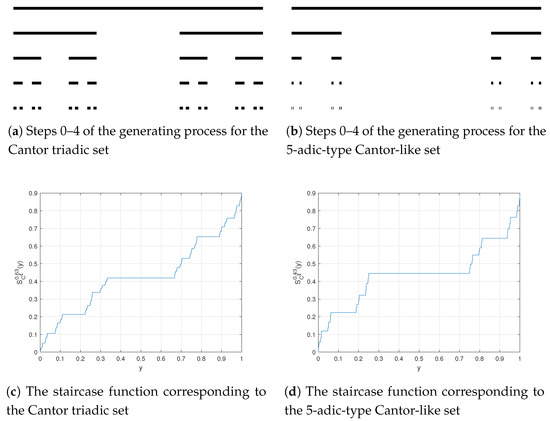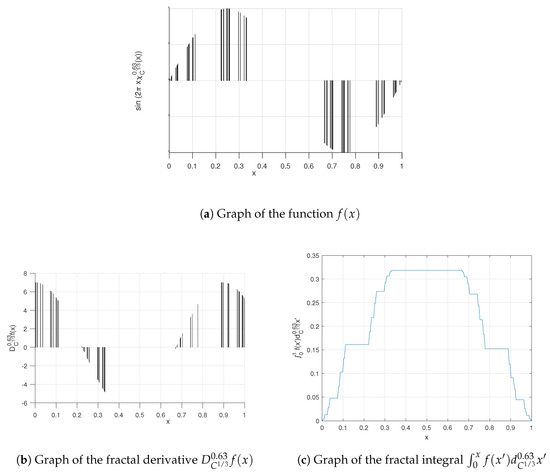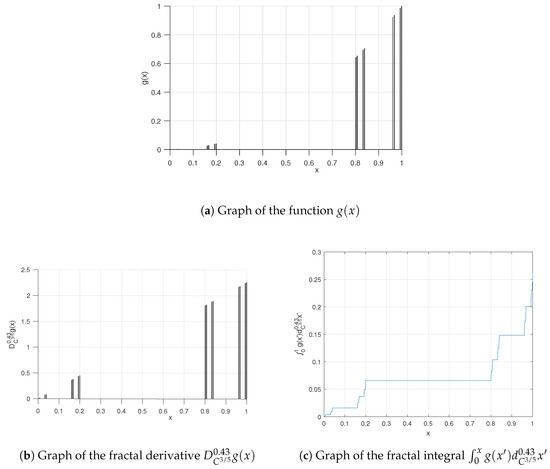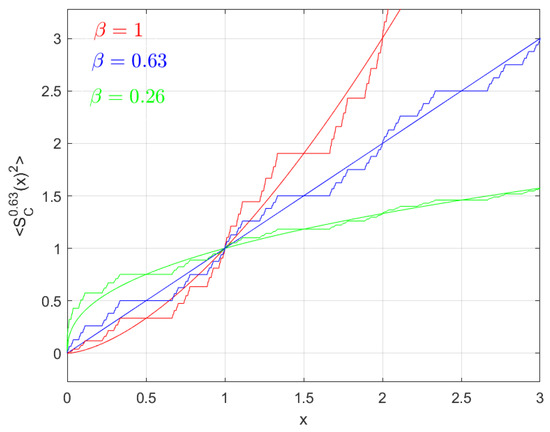Abstract
In this paper, we study -calculus on generalized Cantor sets, which have self-similar properties and fractional dimensions that exceed their topological dimensions. Functions with fractal support are not differentiable or integrable in terms of standard calculus, so we must involve local fractional derivatives. We have generalized the -calculus on the generalized Cantor sets known as middle- Cantor sets. We have suggested a calculus on the middle- Cantor sets for different values of with . Differential equations on the middle- Cantor sets have been solved, and we have presented the results using illustrative examples. The conditions for super-, normal, and sub-diffusion on fractal sets are given.
1. Introduction
It is well known that many phenomena in nature can be modeled by fractals; these shapes can be observed almost anywhere in the natural world [1]. Fractal antennas have maximal length, area, and volume to accommodate a multi-band or wide-band design, which is useful in cellular telephone and microwave communications [2,3,4]. Fractals also play important roles in biology. For example, in the neural and vascular networks of the human body, viruses and certain tumors grow and ramify in a fractal shape [5,6,7]. In these studies, researchers tried to predict and recognize osteoporosis from test results and from the fractal structure of bone texture [8]. Fractals have also been hypothesized to be important for human perception of beauty in artworks [9,10]. Non-Markovian random walks and fractal dimensions which are connected to physical properties of fractal sets were studied in [11,12,13]. The polynomial asymptotic behavior of the Wiener index on infinite lattices including fractals has been given [14].
Anomalous diffusion on fractals has received attention in recent years from various researchers [15,16]. Non-constant diffusion coefficients have been studied [17], and the diffusion coefficient is proportional to a power of the noise intensity [18]. The models for the diffusion coefficient characterize random motions in various regions of parameterized space and relate to the fractal structure as a function of the slope of the map [19,20]. Fractal structural parameters have been applied to obtain porosity and tortuosity for micro-porous solids [21]. The scale-dependent fractal dimension for a random walk trajectory was used to derive the diffusion coefficient [22,23]. The quenched-trap model on a fractal lattice does not lead to continuous-time random walks if the spectral dimension is less than 2 [24].
Fractional calculus has been applied to define derivatives on fractal curves [25,26,27,28,29,30,31,32]. Fractional derivatives have non-local properties, so that they are used to model processes with memory effects [29,30].
Local fractional derivatives were suggested and applied from a physics perspective [33,34] in a formalism called -calculus (or -C), which has also been generalized for unbounded and singular functions [35]. Schrödinger equations on fractal curves were derived using -C and Feynman path methods [36]. A mathematical model of diffraction was given for fractal sets [37]. Non-local derivatives were defined for fractal sets and applied in fractal mediums [38,39,40]. The Fokker–Planck equation for thick fractal absorbers was derived in view of -C [41].
Anomalous diffusion in fractal comb structures, where the anomalous diffusion exponent depends on the fractal dimension of the comb structure, has also been studied [42,43,44], and the theoretical predictions in these works was recently experimentally proven [45]. Recently, as an application of the mathematical model, experimental and simulation results were utilized to model sub-diffusion and super-diffusion in physical processes [46,47].
By conducting research along these lines, we have generalized -C to middle- Cantor sets.
The outline of the paper is as follows. In Section 2, we review -C and the basic tools required. In Section 3, we apply the -C on the middle- Cantor sets. In Section 4, we consider and solve some differential equations on middle- Cantor sets, and, in Section 5, we consider diffusion processes on such sets. Section 4 is devoted to the conclusion.
2. Basic Tools in the Fractal Calculus
In this section, we review the Cantor-like sets and their properties [48], and then summarize -C [33,34,38,39].
2.1. Middle- Cantor Sets
Let us consider a unit interval , and construct the middle- Cantor fractal set from it as follows.
In the first step, we remove an open interval of length from the exact middle of the interval I, to obtain:
In the second step, we pick up two open disjoint intervals with length from the middle of each of the remaining intervals that comprise the set , in order to obtain
After iterating this process infinitely many times, with the set constructed at stage k being denoted by , we obtain the definition of the middle- Cantor set as follows:
It is clear that the set has a self-similarity property, which makes it easy for us to find its fractional dimension. Namely, for every middle- Cantor set, the Hausdorff dimension is given by
where is the Hausdorff measure that was used to derive Hausdorff dimension [48]. Furthermore, the middle- Cantor set has zero Lebesgue measure because [48]:
Remark 1.
If we choose , , , , then we obtain the Cantor triadic set, 4-adic-type Cantor-like set, and 5-adic-type Cantor-like set, respectively. Note that middle-ξ Cantor sets with higher ξ have a larger measure; this was shown by using the idea of differences between Cantor sets [49]. See Section 3 below for more details on these sets.
2.2. Local Fractal Calculus
If is a middle- Cantor set contained in an interval , then the flag function for is indicated by and defined by [33,34]
For a set and a subdivision of the interval , we define
for any with . Given , the associated coarse-grained mass function of the intersection is given by
where the infimum is taken over all subdivisions Q of satisfying . Then, the mass function is given by [33,34]
The integral staircase function of order for a fractal set is defined in [33,34] by
where is an arbitrary real number. A point y is a point of change of a function that is not constant over any open interval involving y. All points of change of y is named the set of change of and is indicated by [33,34]. If is a closed set and every point in it is a limit point, then is called -perfect.
The -dimension of is
We also define the concepts of -limits and -continuity, which will be used in the next section.
For a function and a point , a number l is said to be the limit of h through the points of , or simply the -limit of h as , if given any there exists such that
If such a number exists, then it is denoted by:
A function is said to be -continuous at if
2.3. -Differentiation
If is an -perfect set, then the -derivative of a function u defined on at a point y is defined to be the following, assuming the limit exists [33,34]:
Let u be a bounded function on and J be a closed interval as above [33,34]. Then, we define
and similarly
If is finite for , and is a subdivision of , then the upper -sum and lower -sum for a function u over the subdivision Q are given, respectively, by [33,34]
and
Let u be a bounded function on . We say that u is -integrable on if [33,34] the two quantities
are equal. In that case, the -integral of u on is denoted by and is given by the common value of Labels (22)–(23).
Fundamental Theorem of -Calculus. Suppose that is -continuous and bounded on . If we define by
for all , then:
where is the characteristic function of the middle- Cantor set.
Conversely, if is an -differentiable function, then we have [33,34]
for some function , and, consequently, it follows that
3. Staircase Functions on Middle- Cantor Sets
In this section, we plot middle- Cantor sets and their staircase functions for special cases, in order to present details of the paper.
3.1. The Cantor Triadic Set
The Cantor triadic set is generated by iteration as follows:
- Step 1. Remove an open interval of length from the middle of the interval .
- Step 2. Remove an open interval of length from the middle of each one of the closed intervals with length remaining from step 1.
- ...
- Step k. Remove an open interval of length from the middle of each one of the closed intervals with length remaining from step .
In the case of the Cantor triadic sets, utilizing Equations (4) and (11), we get -dimension as follows:
In Figure 1a, we draw the process mentioned above that established the Cantor triadic set.

Figure 1.
Basic properties of some example Cantor sets.
The staircase functions have important roles in -C, being used in integration and differentiation of functions with fractal support.
3.2. The 5-Adic-Type Cantor-Like Set
The procedure to achieve the 5-adic-type Cantor-like set is similar to that for the Cantor triadic set, only differed to remove the open interval of length in every stage. We exhibit these steps in Figure 1b.
4. Differential Equations on Middle- Cantor Sets
In this section, first, we study the integration and differentiation of functions whose support is a middle- Cantor set. Secondly, differential equations formulated on middle- Cantor sets are suggested and solved using illustrative examples.
Example 1.

Consider a function with the fractal Cantor triadic set support as follows:
where
is the characteristic function of the fractal Cantor triadic set. We plot the function in Figure 2a.

Figure 2.
Graphs relevant to Example 1.
The -derivative of , using conjugacy of -C and ordinary calculus [33,34], is as follows:
where denotes the gamma function. A plot of the function is shown in Figure 2b.
The -integration of , considering conjugacy of -C between the ordinary calculus [33,34], will be as follows:
where we use . In Figure 2c, we plot the integral function of over .
Example 2.

Suppose we have a function on the fractal 5-adic-type Cantor-like set as follows:
This function is sketched in Figure 3a.

Figure 3.
Graphs relevant to Example 2.
The -derivative of is derived by a similar method as used in Example 1, which yields the following result:
We plot in Figure 3b.
In the same manner, we obtain the -integral of as follows:
We plot the -integral of in Figure 3c.
We are going to use the above results and examples for solving differential equations on the middle- Cantor sets.
5. Diffusion on Middle- Cantor Sets
In this section, we define and give conditions for super, normal and sub-diffusion on middle- Cantor sets.
5.1. Super-Diffusion
Let us consider time as continuous and space as a middle- Cantor set. We consider a probability function which is an -differentiable function of the space coordinate x and is a differentiable function of time t in the sense of standard calculus. The fractal diffusion equation for a random walk is suggested with the conditional probability as follows:
with the initial condition
where is a generalized diffusion coefficient, is the Dirac delta function with fractal support. Using conjugacy of -C between standard calculus [33,34], we have the solution for Equation (36) as follows:
Since , then Equation (38) can be written as:
The function is indicated as the probability distribution of super-diffusion on Cantor sets.
Accordingly, the mean square random walk is
Using the upper bound , we have
5.2. Normal Diffusion
Let us consider space as a middle- Cantor set and fractal time associated with the middle- Cantor set, both sets having the same value of and the same dimension . The random walk conditional probability is given by
where is a diffusion coefficient. The solution for Equation (42) with the initial condition Equation (37), utilizing conjugacy of -C between standard calculus, is:
Considering the upper bound on the , we obtain:
The function indicates the probability distribution for normal diffusion with a non-Gaussian propagator.
Applying conjugacy of -C between standard calculus, we arrive at the mean square of displacement
and if we use the upper bound on we can write Equation (45) as follows:
5.3. Sub-Diffusion
Let us consider time as a middle- Cantor set with dimension and space as a middle- Cantor set with dimension . A random walk on this fractal space-time has conditional probability that can be obtained by the following differential equation:
where is a diffusion coefficient. Solving Equation (42) with the initial condition Equation (37), using conjugacy of -C between standard calculus, one can obtain
In view of the upper bounds on , we get
The function is named as the probability of sub-diffusion for a random walk as indicated above.
Similarly to the previous cases, the mean square of displacement in this case will be
and in the same manner we use upper bounds on to get
Example 3.

Consider a random walk model on the fractal 3-adic-type Cantor-like set. The corresponding mean square value displacement of the random walk is given by:
or
where the respective cases , , and are called super-diffusion, sub-diffusion and normal diffusion on the fractal 3-adic-type Cantor-like set, respectively.
In Figure 4, we draw the graphs of mean square value displacement random walk model for super-diffusion, sub-diffusion, and normal diffusion on fractal 3-adic-type Cantor-like sets in the case .

Figure 4.
Graphs of the mean value displacement of the random walk model for super-diffusion (in red), sub-diffusion (in green) and normal diffusion (in blue) in the case α = 0.63; the smoothed curves represent the corresponding processes on the real line.
Remark 2.
We conclude the results of Section 5 as follows:
- 1.
- The diffusion is super-diffusion on the middle-ξ Cantor set if .
- 2.
- The diffusion is normal on the middle-ξ Cantor set if .
- 3.
- The diffusion is sub-diffusion on the middle-ξ Cantor set if .
Remark 3.
In some figures, we have plotted bars instead of points for the graphs of functions with fractal support, in order to make the results more clear.
6. Conclusions
The -calculus is a generalization of ordinary calculus that can be applied on middle- Cantor sets for different values of . Functions with middle- Cantor set support were considered, and their derivatives and integrals were derived using -calculus, which shows the advantage of using -calculus over standard calculus. -derivatives on new fractal sets were discussed and compared for functions with different fractal supports. New differential equations involving -derivatives on middle- Cantor sets have been suggested, which can be used as mathematical models for many physical problems. For example, we suggest conditions for super-, normal, and sub-diffusion on fractal sets.
Author Contributions
All authors contributed equally to this work. All authors have read and approved the final manuscript.
Funding
The second author is on a PhD studentship which was funded by the Engineering and Physical Sciences Research Council, UK.
Conflicts of Interest
The authors declare no conflict of interest.
References
- Barnsley, M.F. Fractals Everywhere; Academic Press: New York, NY, USA, 2014. [Google Scholar]
- Cohen, N. Fractal Antenna Applications in Wireless Telecommunications: Electronics Industries Forum of New England; IEEE: Toulouse, France, 1997. [Google Scholar]
- Cohen, N. Fractal Antennas: Part 2. Commun. Q. 1996, 44, 53–66. [Google Scholar]
- Werner, D.H.; Haupt, R.; Werner, P.L. Fractal Antenna Engineering: The Theory and Design of Fractal Antenna Arrays. IEEE Antennas Propag. Mag. 1999, 41, 37–59. [Google Scholar] [CrossRef]
- Gazit, Y.; Baish, J.W.; Sfabakhsh, N.; Leunig, M.; Baxter, L.T.; Jain, R.K. Fractal characteristics of tumor vascular architecture during tumor growth and regression. Microcirculation 1997, 4, 395–402. [Google Scholar] [CrossRef] [PubMed]
- Gazit, Y.; Berk, D.A.; Leunig, M.; Baxter, L.T.; Jain, R.K. Scale-invariant behavior and vascular network formation in normal and tumor tissue. Phys. Rev. Lett. 1995, 75, 2428–2431. [Google Scholar] [CrossRef] [PubMed]
- Baish, J.W.; Jain, R.K. Fractals and cancer. Cancer Res. 2002, 60, 3683–3688. [Google Scholar]
- Koh, K.J.; Park, H.N.; Kim, K.A. Prediction of age-related osteoporosis using fractal analysis on panoramic radiographs. Imaging Sci. Dent. 2012, 42, 231–235. [Google Scholar] [CrossRef] [PubMed]
- Taylor, R.P.; Micolich, A.P.; Jonas, D. Fractal analysis of Pollock’s drip paintings. Nature 1999, 399, 422. [Google Scholar] [CrossRef]
- Bountis, T.; Fokas, A.S.; Psarakis, E.Z. Fractal analysis of tree paintings by Piet Mondrian (1872–1944). Int. J. Arts Technol. 2017, 10, 27–42. [Google Scholar] [CrossRef]
- Balankin, A.S.; Mena, B.; Martínez-González, C.L.; Matamoros, D.M. Random walk in chemical space of Cantor dust as a paradigm of superdiffusion. Phys. Rev. E 2012, 86, 052101. [Google Scholar] [CrossRef] [PubMed]
- Balankin, A.S. Effective degrees of freedom of a random walk on a fractal. Phys. Rev. E 2015, 92, 062146. [Google Scholar] [CrossRef] [PubMed]
- Golmankhaneh, A.K.; Baleanu, D. New heat and Maxwell’s equations on Cantor cubes. Rom. Rep. Phys. 2017, 69, 109. [Google Scholar]
- Ori, O.; Cataldo, F.; Vukicevic, D.; Graovac, A. Wiener way to dimensionality. Iranian J. Math. Chem. 2010, 1, 5–15. [Google Scholar]
- Poirier, D.R.; Geiger, G.H. Fick’s Law and Diffusivity of Materials. In Transport Phenomena in Materials Processing; Springer: Cham, The Netherlands, 2016. [Google Scholar]
- Ben-Avraham, D.; Havlin, S. Diffusion and Reactions in Fractals and Disordered Systems; Cambridge University Press: Cambridge, UK, 2000. [Google Scholar]
- Petersen, J.S.; Mack, C.A.; Sturtevant, J.L.; Byers, J.D.; Miller, D.A. Nonconstant diffusion coefficients: Short description of modeling and comparison to experimental results. In Advances in Resist Technology and Processing XII; International Society for Optics and Photonics: Bellingham, WA, USA, 1995; Volume 2438, pp. 167–181. [Google Scholar]
- Lindner, B. Diffusion Coefficient of a Brownian Particle with a Friction Function Given by a Power Law. J. Stat. Phys. 2008, 130, 523–533. [Google Scholar] [CrossRef]
- Schell, M.; Fraser, S.; Kapral, R. Diffusive dynamics in systems with translational symmetry: A one-dimensional-map model. Phys. Rev. A 1982, 26, 504–521. [Google Scholar] [CrossRef]
- Klages, R.; Dorfman, J.R. Simple Maps with Fractal Diffusion Coefficients. Phys. Rev. Lett. 1995, 74, 387–390. [Google Scholar] [CrossRef] [PubMed]
- Schieferstein, E.; Heinrich, P. Diffusion Coefficients Calculated for Microporous Solids from Structural Parameters Evaluated by Fractal Geometry. Langmuir 1997, 13, 1723–1728. [Google Scholar] [CrossRef]
- Gmachowski, L. Fractal model of anomalous diffusion. Eur. Biophys. J. 2015, 44, 613–621. [Google Scholar] [CrossRef] [PubMed]
- Bujan-Nuňez, M.C. Scaling behavior of Brownian motion interacting with an external field. Mol. Phys. 1998, 94, 361–371. [Google Scholar] [CrossRef]
- Miyaguchi, T.; Akimoto, T. Anomalous diffusion in a quenched-trap model on fractal lattices. Phys. Rev. E 2015, 91, 010102. [Google Scholar] [CrossRef] [PubMed]
- Uchaikin, V.V. Fractional Derivatives for Physicists and Engineers Vol. 1 Background and Theory. Vol 2. Application; Springer: Berlin, Germany, 2013. [Google Scholar]
- Tatom, F.B. The relationship between fractional calculus and fractals. Fractals 1995, 3, 217–229. [Google Scholar] [CrossRef]
- Kolwankar, K.M.; Gangal, A.D. Fractional differentiability of nowhere differentiable functions and dimensions. Chaos 1996, 6, 505–513. [Google Scholar] [CrossRef] [PubMed]
- Nigmatullin, R.R.; Le Mehaute, A. Is there geometrical/physical meaning of the fractional integral with complex exponent. J. Non-Cryst. Solids 2005, 351, 2888–2899. [Google Scholar] [CrossRef]
- Richard, H. Fractional Calculus: An Introduction for Physicists; World Scientific: London, UK, 2014. [Google Scholar]
- Hilfer, R. (Ed.) Applications of Fractional Calculus in Physics; World Scientific: London, UK, 2000. [Google Scholar]
- Asad, H.; Mughal, M.J.; Zubair, M.; Naqvi, Q.A. Electromagnetic Green’s function for fractional space. J. Electromagn. Wave 2012, 26, 1903–1910. [Google Scholar] [CrossRef]
- Zubair, M.; Mughal, M.J.; Naqvi, Q.A. Electromagnetic Fields and Waves in Fractional Dimensional Space; Springer: Berlin/Heidelberg, Germany, 2012. [Google Scholar]
- Parvate, A.; Gangal, A.D. Calculus on fractal subsets of real-line I: Formulation. Fractals 2009, 17, 53–148. [Google Scholar] [CrossRef]
- Parvate, A.; Gangal, A.D. Calculus on fractal subsets of real line II: Conjugacy with ordinary calculus. Fractals 2011, 19, 271–290. [Google Scholar] [CrossRef]
- Golmankhaneh, A.K.; Baleanu, D. Fractal calculus involving Gauge function. Commun. Nonlinear Sci. 2016, 37, 125–130. [Google Scholar] [CrossRef]
- Golmankhaneh, A.K.; Golmankhaneh, A.K.; Baleanu, D. About Schrödinger equation on fractals curves imbedding in R3. Int. J. Theor. Phys. 2015, 54, 1275–1282. [Google Scholar] [CrossRef]
- Golmankhaneh, A.K.; Baleanu, D. Diffraction from fractal grating Cantor sets. J. Mod. Opt. 2016, 63, 1364–1369. [Google Scholar] [CrossRef]
- Golmankhaneh, A.K.; Baleanu, D. New derivatives on the fractal subset of Real-line. Entropy 2016, 18, 1. [Google Scholar] [CrossRef]
- Golmankhaneh, A.K.; Baleanu, D. Non-local Integrals and Derivatives on Fractal Sets with Applications. Open Phys. 2016, 14, 542–548. [Google Scholar] [CrossRef]
- Golmankhaneh, A.K.; Tunc, C. On the Lipschitz condition in the fractal calculus. Chaos Soliton Fract. 2017, 95, 140–147. [Google Scholar] [CrossRef]
- Ashrafi, S.; Golmankhaneh, A.K. Energy Straggling Function by Fα-Calculus. ASME J. Comput. Nonlinear Dyn. 2017, 12, 051010. [Google Scholar] [CrossRef]
- Sandev, T.; Iomin, A.; Kantz, H. Anomalous diffusion on a fractal mesh. Phys. Rev. E 2017, 95, 052107. [Google Scholar] [CrossRef] [PubMed]
- Sandev, T.; Iomin, A.; Méndez, V. Lévy processes on a generalized fractal comb. J. Phys. A Math. Theor. 2016, 49, 355001. [Google Scholar] [CrossRef]
- Iomin, A. Subdiffusion on a fractal comb. Phys. Rev. E 2011, 83, 052106. [Google Scholar] [CrossRef] [PubMed]
- Zhokh, A.; Trypolskyi, A.; Strizhak, P. Relationship between the anomalous diffusion and the fractal dimension of the environment. Chem. Phys. 2018, 503, 71–76. [Google Scholar] [CrossRef]
- Golmankhaneh, A.K.; Balankin, A.S. Sub-and super-diffusion on Cantor sets: Beyond the paradox. Phys. Lett. A 2018, 382, 960–967. [Google Scholar] [CrossRef]
- Balankin, A.S.; Golmankhaneh, A.K.; Patiño-Ortiz, J.; Patiño-Ortiz, M. Noteworthy fractal features and transport properties of Cantor tartans. Phys. Lett. A 2018, 382, 1534–1539. [Google Scholar] [CrossRef]
- Robert, D.; Urbina, W. On Cantor-like sets and Cantor-Lebesgue singular functions. arXiv, 2014; arXiv:1403.6554. [Google Scholar]
- Kraft, R.L. What’s the difference between Cantor sets? Am. Math. Mon. 1994, 101, 640–650. [Google Scholar] [CrossRef]
© 2018 by the authors. Licensee MDPI, Basel, Switzerland. This article is an open access article distributed under the terms and conditions of the Creative Commons Attribution (CC BY) license (http://creativecommons.org/licenses/by/4.0/).